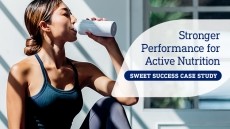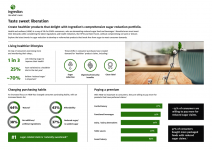Nutrilab works towards a bright future for tagatose
2006, the low-calorie, low-GI sugar replacer has not died a death.
Rather Nutrilab sees a strong future and is working up to full
scale production.
Arla Foods and Nordzucker established a 50-50 joint venture for the production of tagatose from dairy in 2002, called SweetGredients. However in early 2006 it ceased production, saying it was not possible to identify a volume potential to justify continued investments. This could have put an untimely end to a promising new ingredient, were it not for Nutrilab. Nutrilab, a subsidiary of Belgian company Damhert, stepped into the breach and bought up all Arla's remaining supply. It immediately set about creating a market with the launch of consumer products using tagatose, which are distributed through Damher Nutrition to supermarkets in Benelux, northern France, Malta and Denmark. Then, once the European patent on the tagatose molecule, which was owned by Spherix, expired in August 2007, it started producing its own tagatose using an enzymatic process and the raw material galactose, a waste product from a biofuels manufacturing group with with Nutilab has a long-term supply agreement. Although it is currently working out of a pilot plant, Nutrilab is eyeing the ingredients market in the long term and expects to have a full-scale industrial plant producing some 10,000 tonnes a year in operation by September 2009. In the meantime, it is working from the bottom up to create the market. Christian Vastenavond, director of R&D and international operations told FoodNavigator.com that tagatose is being used in chocolate, spreads, cookies, and a home sugar replacer called Tagatesse. At the moment, a new product is being launched about every three weeks. This strategy differs from Arla's in that the Danish group marketed the sweetener to big time food and beverage manufacturers - a top down approach that relied on the customers to create a market. While this approach could work, it takes a lot of faith on the part of the manufacturers and as long as four or five years for a new ingredient to gain market share. By first creating its own tagatose consumer products, Vastenavond said Nutrilab is able to demonstrate to its future ingredients customers there is market and consumer demand. "It is an idea you don't sell with words, but by doing the work step by step," he said. Moreover, since it has encountered technical difficulties along the way and discovered ways to overcome them, it will be able to pass on this advice to customers and provide them with some standards formulas. Another major difference between Nutrilab's and Arla's approaches is that, according to Vastenavond, Arla's chemical process was very expensive, creating considerable waste and requiring a lot of cleaning. The enzymatic process that Nutrilab began developing in 2001 and had finalised by 2006, by contrast, is said to cost a fraction of Arla's. The raw material is extremely cheap. Vastenavond said that, while there was only one patent on the tagatose molecule, there are many patents on the production process out there. In coming up with its own process, Nutrilab had to be sure to navigate these and ensure it did not infringe any of them. Vastenavond claims that Nutrilab is the only company currently producing tagatose, however. While in theory one of the other patent holders could chose to cash in on its IP and start production, they would first need to create a market, then rank up capacity.






















